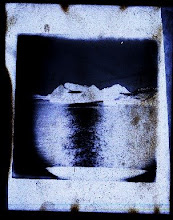
Town just south of Sisimiut, Greenland. Image © Margaret Sharrow, 2008
Once past Hamborgerland, we stopped at or passed a few more settlements on the way to Sisimiut. Again, photographs show settlements clinging to an edge between steep mountains and the sea.
The ferry was gradually losing its tourists here and there, one man wearing army fatigues having gone ashore with a massive pack that probably weighed as much as I did. He was clearly equipped for wild camping. At each stop we collected an increasingly Greenlandic clientele, bearing enormous amounts of luggage including large electrical appliances and oversized children’s toys. By the time the ship turned southward on 31 August, it was clearly the end of the tourist season, as the only non-Greenlanders remaining on board were myself, a Danish woman who was having a tour of the country at the end of her time working in the Home Rule government in Nuuk, and, briefly, the man who had been wild camping. The ferry service used to extend further south, to Nanortalik, but now goes only as far as Narsaq and Qaqortoq; it also used to go much further north, to Upernavik, 72 degrees 50 north, beyond which there are hardly any settlements except Qaanaaq and its few satellites. And there are no ferries at all linking the few isolated settlements and the massive national park on the east coast; aside from flights from Reykjavík to Kulusuk (including a mad day-tripper service), all east Greenlandic transport is pretty well by helicopter, private boat, or, in season, dogsled. There are limits even for the mighty cargo ships; in Greenland, the weather ultimately determines everything.
What do people do if they want to move white goods in winter? Insanely, flying is the only answer. And yes, they do have refrigerators in Greenland.
30 August 2008 17:43 recalled 22 January 2011
Want more? Then please VOTE FOR ME TO BE THE OFFICIAL BLOGGER & ARTIST ON AN EXPEDITION TO THE NORTH POLE! http://www.blogyourwaytothenorthpole.com/entries/166
send an image of ULTIMATE STILLNESS to my exhibition http://www.wooloo.org/open-call/entry/182907
and stay tuned for another episode tomorrow!






















